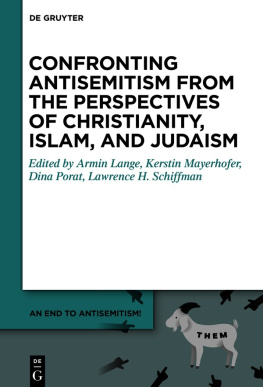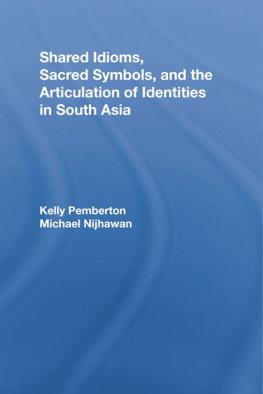ISBN 9783110582420
e-ISBN (PDF) 9783110671773
e-ISBN (EPUB) 9783110671889
Bibliographic information published by the Deutsche Nationalbibliothek
The Deutsche Nationalbibliothek lists this publication in the Deutsche Nationalbibliografie; detailed bibliographic data are available on the Internet at http://dnb.dnb.de.
2020 Armin Lange, Kerstin Mayerhofer, Dina Porat, Lawrence H. Schiffman, published by Walter de Gruyter GmbH, Berlin/Boston // The book is published with open access at www.degruyter.com.
This work is licensed under the Creative Commons Attribution-NonCommercial-NoDerivatives 4.0 International License.
Notes
R. S. Wistrich, Antisemitism: The Longest Hatred (London: Methuen, 1991).
A. Lange, A. Muzicant, D. Porat, L. H. Schiffman, M. Weitzman, An End to Antisemitism! A Catalogue of Policies to Combat Antisemitism (Brussels: European Jewish Congress, 2018).
A. Lange, K. Mayerhofer, D. Porat, and L. H. Schiffman, eds., Comprehending and Confronting Antisemitism: A Multi-Faceted Approach, vol. 1 of An End to Antisemitism! (Berlin: De Gruyter, 2019).
Lange, Mayerhofer, Porat, and Schiffman, Comprehending and Confronting Antisemitism, xixvii.
Introduction
Armin Lange
Kerstin Mayerhofer
To effectively counteract contemporary antisemitism, it is important to recognize the traditions that feed modern hatred of Jews. Manifestations of antisemitism in contemporary cultures and societies are manifold. They range from hate speech to actual physical violence and can be encountered in political or economic realms, in social discourses of nation and race, or on a meta-level both culturally and ideologically. Religious and theological antisemitism can be regarded as the source for most of the other forms of Jew-hatred, especially in its shaping of a canon of discriminatory images and perceptions of the Jews as essentially different from anyone not Jewish.
Many contributions to the conference An End to Antisemitism! confirmed that ancient and medieval religious traditions of Jew-hatred still have an impact today. Their canon of antisemitic traditions remains vivid, and it is necessary to first recognize the traditions in question to subsequently eradicate them from contemporary discourse.
Usage of Terms
The usage of the term antisemitism is as complex as the genesis of the term itself. This is why some of the contributions in this volume dispute that the texts they study are antisemitic in nature. They rather wish to apply a more general term of Jew-hatred that subsumes all different forms of polemics against and persecutions of Jews. Focusing on theological concepts, especially in Christian religious history, some of the contributions also claim that specifically religious stereotypes confirm a notion of anti-Judaism that is not necessarily connected with other discriminatory allegations against Jews other than them accepting a system of beliefs and practices differing from and competing with Christianity. However, these traditions are also in fact clearly polemical and express negative images of and attitudes against Jews that reach far beyond the scope of religious alterity.
This seeming contradiction to the above claim of the ancient and medieval roots of modern antisemitism in some of the present volumes contributions can be explained in two ways. (1) Not all of the ancient and medieval roots of modern antisemitism are perceived by all authors to be antisemitic in nature themselves but are regarded as expressions of the rejection of Judaism for other reasons than Jew-hatred. (2) Despite the conference being based on the IHRAs Working Definition of Antisemitism, several contributions employ different definitions of antisemitism. While some essays perceive all forms of Jew-hatred and anti-Jewish discrimination as antisemitic, others are more restrictive in their use of the term antisemitism as mentioned above. The editors of the present volume have chosen not to unify the usage of the various terms mentioned above. However, each author has been asked to present a definition according to which they understand and use a respective term.
Symbols, Images, and Traditions in the Formation of (Religious) Group Identities
Both individual and group identities are constructed and maintained by way of distinction and differentiation. A child develops its identity by differentiating itself from its mother in a process of several years. The construction of a personal identity includes thus not only the recognition I am I but also the recognition You are not me. Social and religious group identities are constructed and maintained in a similar way, that is, in differentiation from other social or religious groups implying thus the recognition We are we but not you. Group identities are thus constructed by way of distinguishing an in-group from an out-group, orto say it in other wordsa collective I from a collective Other. In the case of some religions, such a group identity is constructed by defining a unifying set of religious doctrines that distinguishes this religion from all other religions. In the case of other religions, the same goal is reached by a set of religious, moral, and ritual rules that achieve the same differentiation.
How religious identity is understood and constructedboth in terms of differentiating oneself from another (I am not you) and understanding oneself as being part of a distinct group (We are not them)is thus a process inextricably linked to how religions are shaped. In establishing a new system of beliefs, values, and moral codes, religions need an opposite against which to define these beliefs, values, and moral codes and to prove their validity. On the other hand, they help to form communal spirits, feelings of solidarity, and shared identity. When members of the same group are brought together and held responsible for by the same religious beliefs, values, and moral codes, a common sense of togetherness and identity is shaped. This is true for all major religions.
The construction of religious group identities in monotheistic religions qua definition is especially competitive. The claim that there would be only one god negates all other religions to a much larger extent than in the case of polytheistic religions. A polytheistic religion can differentiate itself from another polytheistic religion without rejection of their opposite religious group identity. As an example, the claim of a collective We to believe in Isis does not need to deny the veracity of veneration of Mithras in its differentiation from a collective Them. The construction of the religious group identity of the Isis mystery cult, therefore, did not depend solely on the differentiation from other mystery cults such as the Mithras cult. There is no need to fully negate another religious belief system in order to corroborate the very rationale of their own religious existence. Monotheism, however, beyond differentiation, implies rejection and condemnation of the religious Other against which its very own religious group identity is formed by default. If there can be only one god, then all other gods must be void.
This is even more so the case when a given monotheistic religion developed out of a preexisting one, that is, Christianity out of Judaism and Islam out of both Judaism and Christianity. Rejection, condemnation, and dismissal of a monotheistic ancestor religion is, if not a necessity, at least an obvious choice in the formation of the religious group identity of a newly born monotheistic religious group.






